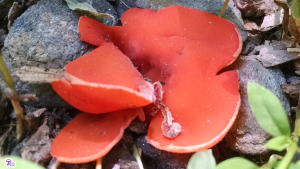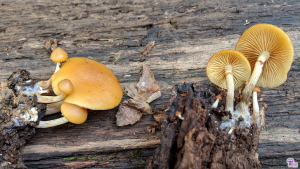#007: Omphalotus illudens, the Jack-O-Lantern Mushroom [Archived]
Note: this is an archived post. You can read the current version of this post here.
Fungus Fact Friday #007: Spotlight on Omphalotus illudens, the “Jack-O-Lantern mushroom”. If the spirit of Halloween were a mushroom, it would be O. illudens. This mushroom is commonly known as the “Jack-O-Lantern mushroom” for a couple of good reasons. First, it is bright orange, like the pumpkins that decorate doorsteps all over the United States in October. Not only is the cap orange, but so are the gills, the stipe, and the interior. Second, the mushroom’s gills glow in the dark, especially when the mushrooms are young and fresh. There are stories of this glow being bright enough to use a clump of mushrooms as a torch. Again, this is reminiscent of the jack-o-lanterns carved out for Halloween. Furthermore, the mushroom often has a sweet smell and is poisonous. Nothing says Halloween like something that is orange, glows in the dark, smells sweet, and has a sinister side.
O. illudens fruits in the summer and fall and can often be confused with some edible chanterelles. The toxins in O. illudens are gastrointestinal irritants, so you won’t die if you make that mistake but you will be punished with symptoms of food poisoning. However, these mushrooms can easily be distinguished from each other if you know what to look for. O. illudens is saprobic on hardwoods and thus only grows from wood (or from buried wood, in which case it can appear terrestrial). If the mushrooms are centered around a dead tree or are growing right at the base of a tree, they are probably O. illudens. Chanterelles are mycorrhizal, so they are always terrestrial. O. illudens has true gills, whereas chanterelles have false gills which are more like folds or ridges that run down the stipe (this distinction becomes more obvious when you have found both species). O. illudens tends to fruit in clusters where many mushrooms sprout from the same point while chanterelles tend to have individual fruiting bodies scattered around an area. O. illudens tends to smell sweet, unlike the earthy smell of chanterelles. And of course, chanterelles do not glow in the dark. The best way to understand the differences between the two is to learn from an experienced mushroom hunter. Even I thought O. illudens was a chanterelle the first time I saw it.
See Further:
http://botit.botany.wisc.edu/toms_fungi/oct97.html (O. olearius is the name for the European species of Jack-O-Lantern mushroom. As with many fungi, there is some confusion as to whether or not the North American and European varieties are the same species. Recent research appears to have pushed the debate in favor of their being separate species. There are actually three North American species: O. olivascens is found west of the Rocky Mountans and has more greenish tones, O. subilludens is found in the American south and can only be distinguished by microscopic analysis, and O. illudens is found east of the Rocky Mountains and is the species described above. Regardless of the name, Tom Volk and I are both writing about the Eastern North American Jack-O-Lantern.)
http://www.mushroomexpert.com/omphalotus_illudens.html (If you scroll to the very bottom of the page, he finally admits that O. illudens does glow.)
http://www.messiah.edu/oaks/fungi_on_wood/gilled%20fungi/species%20pages/Omphalotus%20illudens.htm







![#011: Characteristics of Kingdom Fungi [Archived]](https://www.fungusfactfriday.com/wp-content/themes/hueman/assets/front/img/thumb-small-empty.png)



4 Responses
[…] produce light using the same chemical reactions that fireflies use. If you read last week’s FFF post, you are already aware that certain fungi, such as Omphalotus illudens, produce mushrooms that […]
[…] For more information on O. illudens, including how to distinguish it from chanterelles, see FFF#007. Another good edible is Craterellus cornucopioides/fallax (“The Black Trumpet”). The flesh […]
[…] illudens – the “Jack-O-Lantern mushroom” (FFF#007) – is also frequently confused with Golden Chanterelles. It fruits from decaying wood, but that […]
[…] mushrooms (Omphalotus illudens, FFF#007) also resemble H. aurantiaca and are perhaps more difficult to distinguish than the golden […]